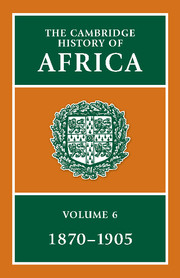Book contents
- Frontmatter
- Introduction
- 1 Africa on the Eve of Partition
- 2 The European Partition of Africa: Origins and Dynamics
- 3 North Africa
- 4 Western Africa, 1870–1886
- 5 Western Africa, 1886–1905
- 6 Western Equatorial Africa
- 7 Southern Africa, 1867–1886
- 8 Southern and Central Africa, 1886–1910
- 9 Portuguese Colonies and Madagascar
- 10 East Africa 1870–1905
- 11 The Nile Basin and the Eastern Horn, 1870–1908
- 12 The European Scramble and Conquest in African History
- Bibliographical Essays
- Bibliography
- Index
- Map 9 West Africa, c. 1870">
- Map 10 West Africa, c. 1905
- Map 13 The Congo Independent State
- Map 26 Ethiopia, the Nile Valley and the Horn in the era of Menelik II
- References
7 - Southern Africa, 1867–1886
Published online by Cambridge University Press: 28 March 2008
- Frontmatter
- Introduction
- 1 Africa on the Eve of Partition
- 2 The European Partition of Africa: Origins and Dynamics
- 3 North Africa
- 4 Western Africa, 1870–1886
- 5 Western Africa, 1886–1905
- 6 Western Equatorial Africa
- 7 Southern Africa, 1867–1886
- 8 Southern and Central Africa, 1886–1910
- 9 Portuguese Colonies and Madagascar
- 10 East Africa 1870–1905
- 11 The Nile Basin and the Eastern Horn, 1870–1908
- 12 The European Scramble and Conquest in African History
- Bibliographical Essays
- Bibliography
- Index
- Map 9 West Africa, c. 1870">
- Map 10 West Africa, c. 1905
- Map 13 The Congo Independent State
- Map 26 Ethiopia, the Nile Valley and the Horn in the era of Menelik II
- References
Summary
In 1867, a solitary diamond was picked up by chance near the appropriately named settlement of Hopetown on the Orange river frontier of the northern Cape Colony. It was sent to the nearest magistracy, Colesberg, and from there by post to Grahamstown, where it was identified. When it arrived in Cape Town, Richard Southey, colonial secretary to the Cape government, declared in words both celebrated and prophetic: ‘Gentlemen, this is the rock on which the future success of South Africa will be built.’ New finds were reported daily from alluvial diggings along the Orange and Vaal rivers and their tributaries, and more importantly by 1870 diamonds were also being found in the open veld around the area to become known as Kimberley. Within five years it had become the world's largest producer of diamonds, outstripping even Brazil. A new era in the history of southern Africa had begun.
In 1870, the political economy of Southern Africa was characterised by tremendous regional diversity. African kingdoms, Afrikaner republics and British colonies co-existed in a rough equilibrium of power, but pursuing widely differing social and economic goals. Although most Africans lived in largely self-sufficient agrarian societies, few were untouched by the coming of the merchant and the missionary. South of the Limpopo, much of the region was dominated by the operations of commercial capital derived from the mercantile enclaves of the coastal Cape Colony and Natal. Trading insinuated itself into the largely pre-capitalist agricultural economies of African peoples and into the proto-capitalist agricultural economies of the Afrikaners on the highveld, while the demands from Cape merchants for cattle and the firearms they brought in exchange profoundly affected the pastoral societies of south-western Africa, transforming the nature of warfare in the region.
Keywords
- Type
- Chapter
- Information
- The Cambridge History of Africa , pp. 359 - 421Publisher: Cambridge University PressPrint publication year: 1985
References
- 2
- Cited by

